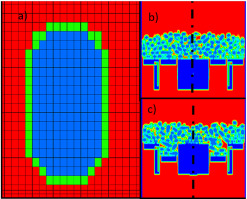当前位置:
X-MOL 学术
›
Int. J. Therm. Sci.
›
论文详情
Our official English website, www.x-mol.net, welcomes your
feedback! (Note: you will need to create a separate account there.)
Simulation of a reacting agitated bed of straw pellets by a resolved coupled DEM/CFD method using a blocked-off approach
International Journal of Thermal Sciences ( IF 4.9 ) Pub Date : 2020-06-01 , DOI: 10.1016/j.ijthermalsci.2020.106332 F. Buss , S. Wirtz , V. Scherer
International Journal of Thermal Sciences ( IF 4.9 ) Pub Date : 2020-06-01 , DOI: 10.1016/j.ijthermalsci.2020.106332 F. Buss , S. Wirtz , V. Scherer

|
Abstract A resolved coupled DEM/CFD approach including a so called “blocked-off” method is presented which allows a continuous transition from the dense reacting pellet bed, with a CFD mesh resolving the voids between the pellets, to the freeboard above the pellet bed with a volatile gas flame present, where much coarser meshes are sufficient. The approach is tested and evaluated simulating the processes in a static bed and in a mechanically agitated bed of straw pellets. The pellets are approximated as spherocyclinders and treated as thermally thick objects. Momentum, radiation, heat and mass exchange at the interfaces to the pellets are calculated using wall functions, eliminating the requirement of shape specific correlations. Thermochemical source terms are determined by modelling conduction, drying, devolatilization and char burn-out for each fuel object. Local adaption of the effective turbulent viscosity, based on a Very Large Eddy model, accounts for different flow regimes and mesh densities in the pellet bed and the freeboard. Converted pellet mass is transferred to the passing fluid. Flame temperature and species distribution are determined from resulting mass fractions in the CFD domain and provide boundary conditions for thermochemical calculations of the pellets. First results show advantages of the approach, especially for the simulation of agitated fuel beds, by resolving the dynamic interaction between the gas phase and the pellets. This allows to interpret the difference in the reaction progress of static and agitated fuel beds which is difficult to assess by experiments.
中文翻译:

通过使用封闭方法的解析耦合 DEM/CFD 方法模拟秸秆颗粒的反应搅拌床
摘要 提出了一种解析耦合 DEM/CFD 方法,包括所谓的“封闭”方法,该方法允许从密集反应球团床连续过渡,CFD 网格解决球团之间的空隙,到球团床上方的干舷存在挥发性气体火焰时,较粗的网格就足够了。该方法通过模拟静态床和秸秆颗粒机械搅拌床中的过程进行测试和评估。丸粒近似为球环剂,并被视为热厚物体。颗粒界面处的动量、辐射、热量和质量交换是使用壁函数计算的,消除了形状特定相关性的要求。热化学源项通过模拟传导、干燥、每个燃料对象的脱挥发分和烧焦。基于超大涡流模型的有效湍流粘度的局部适应考虑了颗粒床和干舷中的不同流态和网格密度。转化后的球团质量被转移到通过的流体中。火焰温度和物种分布由 CFD 域中产生的质量分数确定,并为球团的热化学计算提供边界条件。第一个结果显示了该方法的优势,特别是对于模拟搅拌燃料床,通过解决气相和颗粒之间的动态相互作用。这允许解释难以通过实验评估的静态和搅拌燃料床的反应进程的差异。基于超大涡流模型的有效湍流粘度的局部适应考虑了颗粒床和干舷中的不同流态和网格密度。转化后的球团被转移到通过的流体中。火焰温度和物种分布由 CFD 域中产生的质量分数确定,并为球团的热化学计算提供边界条件。第一个结果显示了该方法的优势,特别是对于模拟搅拌燃料床,通过解决气相和颗粒之间的动态相互作用。这允许解释难以通过实验评估的静态和搅拌燃料床的反应进程的差异。基于超大涡流模型的有效湍流粘度的局部适应考虑了颗粒床和干舷中的不同流态和网格密度。转化后的球团质量被转移到通过的流体中。火焰温度和物种分布由 CFD 域中产生的质量分数确定,并为球团的热化学计算提供边界条件。第一个结果显示了该方法的优势,特别是对于模拟搅拌燃料床,通过解决气相和颗粒之间的动态相互作用。这允许解释难以通过实验评估的静态和搅拌燃料床的反应进程的差异。考虑了颗粒床和干舷中的不同流态和网格密度。转化后的球团质量被转移到通过的流体中。火焰温度和物种分布由 CFD 域中产生的质量分数确定,并为球团的热化学计算提供边界条件。第一个结果显示了该方法的优势,特别是对于模拟搅拌燃料床,通过解决气相和颗粒之间的动态相互作用。这允许解释难以通过实验评估的静态和搅拌燃料床的反应进程的差异。考虑了颗粒床和干舷中的不同流态和网格密度。转化后的球团质量被转移到通过的流体中。火焰温度和物种分布由 CFD 域中产生的质量分数确定,并为球团的热化学计算提供边界条件。第一个结果显示了该方法的优势,特别是对于模拟搅拌燃料床,通过解决气相和颗粒之间的动态相互作用。这允许解释难以通过实验评估的静态和搅拌燃料床的反应进程的差异。火焰温度和物种分布由 CFD 域中产生的质量分数确定,并为球团的热化学计算提供边界条件。第一个结果显示了该方法的优势,特别是对于模拟搅拌燃料床,通过解决气相和颗粒之间的动态相互作用。这允许解释难以通过实验评估的静态和搅拌燃料床的反应进程的差异。火焰温度和物种分布由 CFD 域中产生的质量分数确定,并为球团的热化学计算提供边界条件。第一个结果显示了该方法的优势,特别是对于模拟搅拌燃料床,通过解决气相和颗粒之间的动态相互作用。这允许解释难以通过实验评估的静态和搅拌燃料床的反应进程的差异。
更新日期:2020-06-01
中文翻译:

通过使用封闭方法的解析耦合 DEM/CFD 方法模拟秸秆颗粒的反应搅拌床
摘要 提出了一种解析耦合 DEM/CFD 方法,包括所谓的“封闭”方法,该方法允许从密集反应球团床连续过渡,CFD 网格解决球团之间的空隙,到球团床上方的干舷存在挥发性气体火焰时,较粗的网格就足够了。该方法通过模拟静态床和秸秆颗粒机械搅拌床中的过程进行测试和评估。丸粒近似为球环剂,并被视为热厚物体。颗粒界面处的动量、辐射、热量和质量交换是使用壁函数计算的,消除了形状特定相关性的要求。热化学源项通过模拟传导、干燥、每个燃料对象的脱挥发分和烧焦。基于超大涡流模型的有效湍流粘度的局部适应考虑了颗粒床和干舷中的不同流态和网格密度。转化后的球团质量被转移到通过的流体中。火焰温度和物种分布由 CFD 域中产生的质量分数确定,并为球团的热化学计算提供边界条件。第一个结果显示了该方法的优势,特别是对于模拟搅拌燃料床,通过解决气相和颗粒之间的动态相互作用。这允许解释难以通过实验评估的静态和搅拌燃料床的反应进程的差异。基于超大涡流模型的有效湍流粘度的局部适应考虑了颗粒床和干舷中的不同流态和网格密度。转化后的球团被转移到通过的流体中。火焰温度和物种分布由 CFD 域中产生的质量分数确定,并为球团的热化学计算提供边界条件。第一个结果显示了该方法的优势,特别是对于模拟搅拌燃料床,通过解决气相和颗粒之间的动态相互作用。这允许解释难以通过实验评估的静态和搅拌燃料床的反应进程的差异。基于超大涡流模型的有效湍流粘度的局部适应考虑了颗粒床和干舷中的不同流态和网格密度。转化后的球团质量被转移到通过的流体中。火焰温度和物种分布由 CFD 域中产生的质量分数确定,并为球团的热化学计算提供边界条件。第一个结果显示了该方法的优势,特别是对于模拟搅拌燃料床,通过解决气相和颗粒之间的动态相互作用。这允许解释难以通过实验评估的静态和搅拌燃料床的反应进程的差异。考虑了颗粒床和干舷中的不同流态和网格密度。转化后的球团质量被转移到通过的流体中。火焰温度和物种分布由 CFD 域中产生的质量分数确定,并为球团的热化学计算提供边界条件。第一个结果显示了该方法的优势,特别是对于模拟搅拌燃料床,通过解决气相和颗粒之间的动态相互作用。这允许解释难以通过实验评估的静态和搅拌燃料床的反应进程的差异。考虑了颗粒床和干舷中的不同流态和网格密度。转化后的球团质量被转移到通过的流体中。火焰温度和物种分布由 CFD 域中产生的质量分数确定,并为球团的热化学计算提供边界条件。第一个结果显示了该方法的优势,特别是对于模拟搅拌燃料床,通过解决气相和颗粒之间的动态相互作用。这允许解释难以通过实验评估的静态和搅拌燃料床的反应进程的差异。火焰温度和物种分布由 CFD 域中产生的质量分数确定,并为球团的热化学计算提供边界条件。第一个结果显示了该方法的优势,特别是对于模拟搅拌燃料床,通过解决气相和颗粒之间的动态相互作用。这允许解释难以通过实验评估的静态和搅拌燃料床的反应进程的差异。火焰温度和物种分布由 CFD 域中产生的质量分数确定,并为球团的热化学计算提供边界条件。第一个结果显示了该方法的优势,特别是对于模拟搅拌燃料床,通过解决气相和颗粒之间的动态相互作用。这允许解释难以通过实验评估的静态和搅拌燃料床的反应进程的差异。











































 京公网安备 11010802027423号
京公网安备 11010802027423号